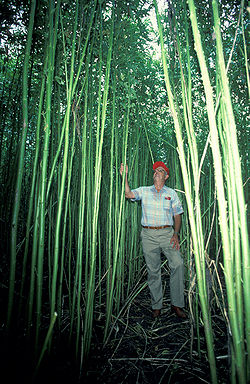- Hibiscus cannabinus
-
Hibiscus

Clasificación científica Reino: Plantae División: Magnoliophyta Clase: Magnoliopsida Subclase: Dilleniidae Orden: Malvales Familia: Malvaceae Subfamilia: Malvoideae Género: Hibiscus Especie: H. cannabinus Nombre binomial Hibiscus cannabinus
Anexo:Especies de HibiscusKenaf (Hibiscus cannabinus) es una especie de planta anual tropical y subtropical. Es originaria de África y Asia.
Contenido
Descripción
Es una planta anual o bianual de hasta 3'5 metros de alto, herbácea con una base leñosa, hojas polimorfas de 10 a 15 cm de longitud. Las flores alcanzan de 8 a 15 cm de diámetro y son blancas amarillas o púrpuras. El fruto es una cápsula de 2 cm de diámetro con varias semillas . Su ciclo de aprovechamiento es de unos 100 a 125 días se cultiva sobre todo en Bangladesh.
Usos
Es una planta de crecimiento rápido que se está desarrollando como fuente de fibras alternativa y versátil para la industria papelera. De su tallo se obtienen dos tipos de fibras, de composición, morfología y aplicaciones distintas:
- a) fibras liberianas de su corteza exterior, más esbeltas y resistentes, adecuadas para un amplio rango de papeles especiales;
- b) fibras del corazón leñoso, más lignificadas y de pequeñas dimensiones, adecuadas para papeles comunes.
Sinonimia
- Abelmoschus congener (Schum. & Thonn.) Walp., Rep. bot. syst. vol. 1, 308. 1842.
- Abelmoschus verrucosus Walp., Rep. bot. syst. vol. 1, 308. 1842.
- Hibiscus aculeatus Don, Gen. Syst. vol. 1, 480. 1831.
- Hibiscus cavanillesii Kostel., Allg. Med.-Pharm. Flora vol. 5, 1857. 1836.
- Hibiscus congener Schum. & Thonn., Beskr. Guin. Pl., 319. 1827.
- Hibiscus radiatus Sieber ex Steud., Nom. ed. vol. 2, 1, 760. 1840., nom. illeg. non Cav. (1787).
- Hibiscus tripartitus Forssk., Fl. aegypt.-arab., 126. 1775.
- Hibiscus verrucosus Guill. & Perr., Fl. Seneg. tent. vol. 1, 87. 1831.
- Hibiscus vitifolius Mill., Gard. Dict. ed. vol. 8, no. 8. 1768., nom. illeg. non L. (1753)
- Ketmia glandulosa Moench, Suppl. Meth. (Moench) 202. 1794 or 1802?[1]
- Hibiscus sabdariffa subsp. cannabinus (L.) Panigrahi & Murti
- Hibiscus asper Hook.f.
- Hibiscus malangensis Baker f. (1939)
- Hibiscus cordofanus Turcz. (1858)
- Hibiscus vanderystii De Wild. (1915)
- Hibiscus verrucosus var. punctatus A.Rich. (1847)
- Hibiscus cannabinus var. punctatus (A.Rich.) Hochr. (1916)
- Hibiscus henriquesii Lima (1921)[2]
Nombre común
- Castellano: cáñamo de la India, cáñamo de gambo, cáñamo Rosella, pavona encendida, yute de Java, yute de Siam.[3]
Referencias
- ↑ http://species.wikimedia.org/wiki/Hibiscus_cannabinus
- ↑ «Hibiscus cannabinus». Conservatorio y Jardín Botánico de Ginebra: Flora africana. Consultado el 7 de septiembre de 2010.
- ↑ http://en.wikipedia.org/wiki/Kenaf
- Mansfeld's World Database of Agriculture and Horticultural Crops (1998-). IPK Gatersleben. 2009 Sept 02 [1].
- USDA, ARS, National Genetic Resources Program. Germplasm Resources Information Network - (GRIN) [Data from 07-Oct-06]. [2]
Enlaces externos
 Wikimedia Commons alberga contenido multimedia sobre Hibiscus cannabinus. Commons
Wikimedia Commons alberga contenido multimedia sobre Hibiscus cannabinus. Commons Wikiespecies tiene un artículo sobre Hibiscus cannabinus. Wikispecies
Wikiespecies tiene un artículo sobre Hibiscus cannabinus. Wikispecies- Greenfiber Net, A B2B platform to promote the use of natural fibres like kenaf, jute, and allied.
- American Kenaf Society (AKS), Founded in 1997 with individuals and organizations working directly or indirectly with kenaf and kenaf-based products, plus those with environmental concerns.
- CCG International (CCG), Leading International efforts to promote the use of kenaf and allied natural plant fibres.
- International Jute Study Group, A UN collaboration for learning various aspects of Jute and Kenaf. Its headquarter is located in Dhaka, Bangladesh. It targets business societies in India, Bangladesh, and Thailand.
- About the Kenaf Plant, Vision Paper - Gives detailed description of kenaf plant and provides many links to kenaf industry. Pioneers in the kenaf paper industry.Produced first ever chlorine free 100% tree-free kenaf paper in 1992.
- Information about Kenaf in German language, Provides information on Market Place, News, and Links about Kenaf in German language.
- Nachwachsende-Rohstoffe, A German site for Kenaf and other agricultural commodities related articles (Also available in English).
- Alternative Field Crops Manual
- Kenaf: Taking Root? 1995 article by Brooke Wurst
- Mabberley, D.J. 1987. The Plant Book. A portable dictionary of the higher plants. Cambridge University Press, Cambridge. 706 pp. ISBN 0-521-34060-8.
Wikimedia foundation. 2010.
